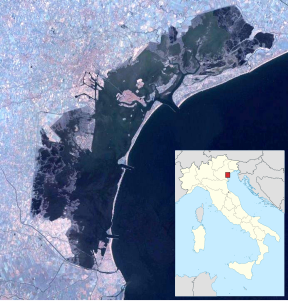La Certosa
| La Certosa | ||
|---|---|---|
| La Certosa between the old town (left) and Vignole (right). In the foreground the Lido , right behind Murano . | ||
| Waters | Venice lagoon | |
| Geographical location | 45 ° 26 '1 " N , 12 ° 22' 24" E | |
|
|
||
| length | 950 m | |
| width | 370 m | |
| surface | 24.2 ha | |
| Highest elevation | 1 m | |
| Residents | uninhabited | |
La Certosa , also called Isola della Certosa, is an island in the Venice lagoon . It has an area of 24.2 hectares and is located between the eastern end of the historic center of Venice , Murano and Lido . It forms a group of islands with Le Vignole and Sant'Andrea and its long peninsula Forte S. Andrea. La Certosa is only 250 m from S. Pietro di Castello and a little more than 500 m from the Lido.
history
The archipelago of La Certosa and Sant'Andrea is located on one of the former main access roads from the Adriatic to the lagoon. Until the beginning of the 20th century, La Certosa consisted of two islands separated by a canal. This was filled in like so many in Venice. Therefore the northern part is called la nuova Certosa , because the southern part was inhabited earlier. In the north there is still a diverse flora , including the oldest mulberry tree .
In December 1199 an Augustinian community was founded here. Marco I. Nicola, Bishop of Castello , gave it to Domenico Franco, the priest of Santa Sofia in Venice, along with the land belonging to it. The monastery was dedicated to St. Andrew . The church was consecrated in 1219.
On June 15, 1424, Pope Martin V turned to the abbot of the Benedictine monastery of San Giorgio Maggiore to induce him to distribute the few remaining monks to other monasteries. The Senate decided that the monastery should be handed over to the Carthusians of Florence . The monastery was named San Bruno. According to their rule of the order, the new residents built fifteen separate monk cells, each with its own garden and a well.
Mariano da Volterra, the first prior of the new Charterhouse , made some repairs, but in 1430 the buildings were described as badly dilapidated. Between 1490 and 1505 the monastery was renovated. After 1485 there were bonuses that changed the island landscape. This created avenues and gardens. In 1492 the new church was completed according to plans by Pietro Lombardo . Painters like Titian , Vivarini and Tintoretto worked in it. Some of these works of art are now in the Accademia . The island became the burial place for numerous Venetian nobles and for two doges .
Before 1564 new residential buildings were built for the monks. Around 1581 the rive , the bank fortifications were built. The residents could live from the garden and from viticulture, but also from sheep.
In 1576 the plague hit the island and some buildings had to be abandoned. In the course of the 17th century the buildings such as the bell tower or the church were constantly restored, in 1721 the church was rededicated after extensive work. In the 18th century there were considerations to move the municipal cemetery here, but it stayed with San Michele .
In December 1807, by order of the French under Napoleon , the monks had to give up their 15 cells and leave the island. In 1812 a new ammunition store was added to the 1632 store , and the church was converted into a depot. Of the older buildings, only the casello delle polveri from 1632, which is on the southern edge of the island opposite Sant'Elena , has been preserved. Almost nothing has been preserved from the monastery and its garden, the cells and the outbuildings. Around 1870 sails were made on the island.
On January 3, 1953, a wagon filled with hand grenades exploded on the island . Seven workers were killed. In 1958 the younger ammunition store was also abandoned, and in 1968 the small barracks.
After nearly three decades of decline, efforts began in 1997 to make the island habitable again. Cesare Scarpa and Flavio Cogo, the heads of the Comitato Certosa e Sant'Andrea , called for the establishment of an urban park on the island. To this end, a Certosa Day was initiated in which thousands of Venetians took part. The regiment based on Sant 'Andrea ceased its activities in the north of La Certosa. In 2003 , an educational institution for environmental protection was established with funding from the Province of Venice . In 2004, the renovated buildings could be handed over to young entrepreneurs, who mainly loved rowing and sailing. Work is currently underway to revitalize the nearby port, Forte di Sant'Andrea . In 2009 a monograph on the history of the island was published.
traffic
The Vaporetto lines 4.1 / 4.2 or in the evening lines 5.1 / 5.2 of the ACTV generally stop on the island in summer and on request in winter.
literature
- Davide Busato, Paola Sfameni: L'isola della Certosa di Venezia , Centro Studi Riviera Brenta, 2009.
Web links
- L'isola di Certosa e il Forte di S. Andrea: Venezia verso l'Adriatico , website of the province

